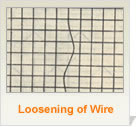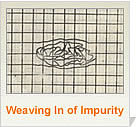 |
10. Loosening of Wire: Twisting or moving of single or some pieces of warp wire or weft wire. |
 |
11. Weaving In of Impurity: Non-woven materials woven in the fabric cause deformed opening or blocking to affect the neatness of surface. The soft stuff that cannot be moved, also not protruding, may remain as defects; the hard and protruding stuff must be picked out, otherwise it may damage the neighboring wire mesh. |
|
4. Flattened Wire: Weft or warp wire deformed by mechanical operation may cause deformed opening when woven into wire mesh. 13. Density Error: Aperture density exceeding density scope causes unqualified mathematics average value of aperture. 5. Weft Wire Backward: Weft wire backward may cause irregular aperture or even worse, to make the opening exceeding deviation allowance. 6. Irregular Aperture: Regular big or small openings between weft wires. One big opening is followed with one small opening for Plain Woven wire mesh. For Twill Woven, usually two big opening then two small, or one big then three small, etc. 16. Bulging Out: One site or some sites along warp direction bulges out, while the aperture does not change much. This kind of defect influences the surface quality of wire mesh. 7. Cloud Shape Weaving: Cloud shape bulging formed in the surface of wire mesh. Caused by weft wire pressed in a different direction. Usually occurs during weaving of medium sized wire mesh. 8. Roll loosening: The wire mesh has no intensive feeling, can be twisted along warp or weft wire at an angle of 45°. 9. Other defects: Including dirty surface, mechanical folding, rusty spots, extra roll width difference, insufficient roll length, breaking of wire mesh, etc. |
|
[Totle: 2 , Currentpage: 2 ] <<Previous Next>>